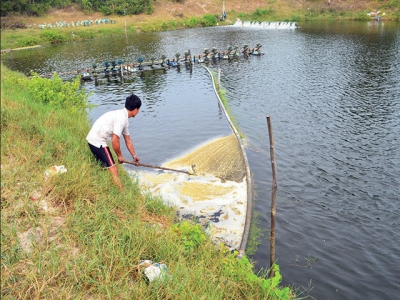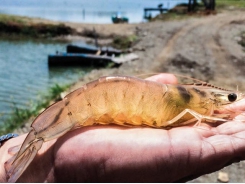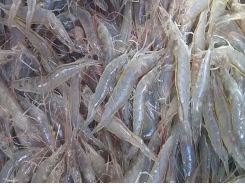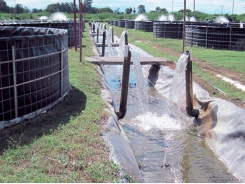Caveat emptor when seeking for EMS solutions

A simple, single all-encompassing solution for AHPN is unlikely
AHPN is caused by a common bacterium, but wholesale disinfection of aquatic ecosystems is not a sustainable practice.
“Caveat emptor” is Latin for “let the buyer beware,” a phrase with which most of us are familiar. While some might take this as a blanket admonition that no one can be trusted, I think it prudently advises all of us, among other things, not to look for easy fixes to complex problems.
Governments make certain practices illegal, and where impacts on consumers can be substantial, they enforce labeling requirements, as an example, that ensure buyers understand there may be risks associated with the use of some products. Nonetheless, this adage remains very much a truism in today’s world.
Disease solutions
With every major disease outbreak in shrimp farming, there have been those who are understandably drawn to the large profit potential that a widespread solution would offer. Yet I am not aware of a single instance where the tools offered significantly impacted the disease process in the long run and remained in common use. Tools that provide long-lasting and broad-reaching solutions are not the norm for controlling diseases in farmed shrimp.
Many compounds kill bacteria and viruses, and more are being found all the time. Disinfectants – chemicals and ion-based compounds, among others – join a variety of plant extracts, chlorine, ozone and other bacteria as documented solutions to kill many different types of bacteria, including the Vibrio implicated in early mortality syndrome (EMS) or acute hepatopancreatic necrosis (AHPN). It is important to recognize that killing bacteria under controlled conditions in a lab is not equivalent to controlling the processes that allow the disease to occur at farms.
If killing the bacteria was all that was needed to prevent or stop infection, the use of chlorine might have prevented the AHPN problem from developing in the first place. Some have speculated that the overuse of some of the routinely used disinfection tools may have created niches that have allowed bacteria such as the etiologic agent of AHPN to evolve and thrive. Wholesale attempts at disinfection of large swatches of aquatic ecosystems could be useful in some cases, but in the big picture, this is not a sustainable practice.
Understanding disease process
The aquaculture community is still very much in the early stages of understanding the disease process of AHPN. The pathology is well documented, and scientists have been able to isolate the pathogen and infect shrimp to produce the characteristic pathology. But even though scientists can reisolate the bacterium and repeatedly get a pathognomonic disease process, the disease process in the field may not be as simple. Laboratory environments are usually highly controlled, whereas the field is subject to a myriad of variables.
Disease is a result of interactions among the host (shrimp in this case), the environment and the pathogen. Host genetics, species, life stage and pathogen-free status are all contributing factors. The environment in which animals are produced is constantly changing and quite complex, with stress all too often being the norm.
The presence of nutrients that encourage the growth of one bacterial species over others, a myriad of metabolic by-products and end products, and the physical and chemical parameters of the water are also elements of disease susceptibility. The pathogen itself may have a preferred mechanism for producing disease that affects its virulence. There is little reason to believe that EMS/AHPN has a simple disease process.
There is no evidence that the Vibrio behind AHPN is an obligate pathogen that produces disease merely by its presence. There are threshold levels below which one does not see acute disease, and it is likely present in many ecosystems where no acute disease is observed. This is normal for most diseases. A simple, single all-encompassing solution for AHPN is unlikely. Caveat emptor!
Pathogen detection
Several recent articles purport that the availability of a tool to detect the pathogen responsible for AHPN will “solve” the problem. Unfortunately this is misleading, and while detecting the pathogen is of critical importance in learning how to live with it, this is a tool for detection and not a solution.
This tool, known as polymerase chain reaction (PCR) allows specific sequences of DNA to be copied, making it easy to detect very low levels of DNA. This technology utilizes a specific DNA sequence that allows ready detection of the organism of interest and no others. The amplified sequence should be unique to the specific organism for which one is screening.
The etiologic agent of EMS is a variant of a common marine bacterium, Vibrio parahaemolyticus. This organism is nearly ubiquitous in marine environments, and there are innumerable strains, with more being characterized all of the time. While PCR is a very valuable tool, until it is in widespread use, and testing confirms its specific identification of the EMS Vibrio, there remains the specter that it will not detect just the pathogenic form. Caveat emptor!
Perspectives
Caution is in order for the time being. A number of PCR probes are currently available and in use, and there is the possibility of false positives. The mere presence of a PCR-reactive isolate could cause panic in areas where there has been no clearly identified disease. Confirmation by bioassay of presumptive positives to ensure pathogenicity is a prudent intermediate step to take until more definitive data are available.
It is important to bear in mind that even though EMS/AHPN appears to have been present in farms for at least four years, it is still spreading, and we are still in the early phases of understanding what is occurring. If it is similar to other pathogens, you can expect the solution to EMS will not be a simple one. And since it is caused by bacteria, not a virus, it is not likely that we will see the development of tolerance to AHPN any time in the near future. Let the buyer beware is a wise approach to take toward quick solutions.
Có thể bạn quan tâm
Phần mềm

Phối trộn thức ăn chăn nuôi

Pha dung dịch thủy canh

Định mức cho tôm ăn

Phối trộn phân bón NPK

Xác định tỷ lệ tôm sống

Chuyển đổi đơn vị phân bón

Xác định công suất sục khí

Chuyển đổi đơn vị tôm

Tính diện tích nhà kính

Tính thể tích ao hồ




 Intensive production of Pacific white shrimp in a…
Intensive production of Pacific white shrimp in a…  Raceway systems offer tools for EMS management
Raceway systems offer tools for EMS management